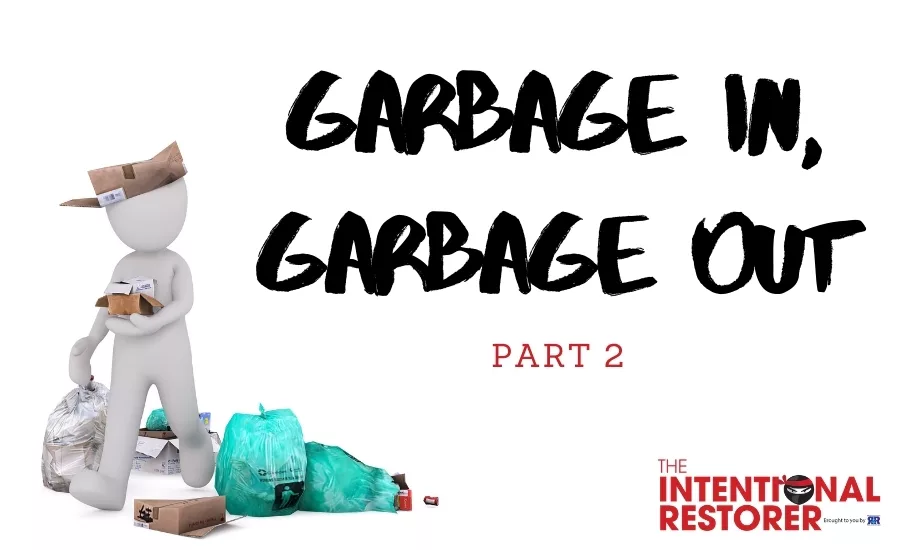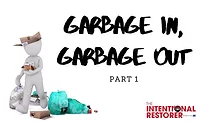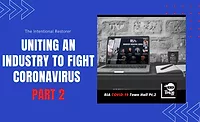The Intentional Restorer
Garbage In, Garbage Out (Part 2): The Imperial Order of the Work Order

Manager 1 complains, “I can’t get my workers to stop going to the hardware store multiple times in a day.”
“How detailed are your work orders?” the friendly neighborhood restoration coach asks.
For this segment of “Garbage In - Garbage Out” (see GIGO 1), we will discuss how an organization can align their processes with their vision to ensure they are not undermining their goals. We will take a trip down memory lane and construct this article in the fashion of the Choose Your Own Adventure Series paperbacks that were popular in the 90s.
As I have said before, I am a bridge millennial. I am technically Gen Y but I believe that my perspectives and experiences are more in line with Gen X. With The DYOJO Podcast, my goal has been to help growth-minded professionals to shorten their DANG learning curve, which often requires listening to and learning from those who have been there, done that (BTDT) and lived to tell others about it. By utilizing a structure that will bring some nostalgia to 90s kids, let’s see if we can unpack some of these common dysfunctions in the skilled trades.
How do you think Manager 1 answers the question we posed above regarding work orders?
- “”What’s a work order?” - advance to paragraph 1
- “They’re pretty good. Why are you busting my butt?” - advance to paragraph 2
- “I’d like to see how Company X does theirs any better. Give me a break.” - advance to paragraph 3
- “Flawless.” - advance to paragraph 4
Paragraph 1 - Definition of a Work Order
“What’s a work order?”
Define a work order: what should be in it and why it is important.
My second-ever article submitted to R&R was a little expose titled Peeling Back 5 Layers of Communication in a Restoration Business. In this article, we dug into the many layers that contribute to a customer calling your office wondering what the heck is going on with their project. Another common dysfunction in the skilled trades.
Again, in order to fix this, we will need to address the system from top to bottom and will need every layer of our organization to be invested in the restoration of our process. Communication is our organization showing our customers that we value them. Clarity and consistency is our organization showing our employees that we value them.
In order to achieve the ever-coveted, rarely-achieved accountability in your organization, we have to communicate clearly and consistently at every level of your organization. In the layers we discussed:
- Clarity at the point of work intake - (see video Garbage In, Garbage Out)
- Clarity at the point of work initiation
- Clarity within the organization
- Clarity within your work communication
Younger readers may be surprised that even in 2010, I arrived at one of the largest restoration companies in our industry and they were still using carbon copies for hand written work orders. There is nothing wrong with old tech; use what you have and make it work. But, if your handwriting is illegible (which is the case for most people in the skilled trades), then you're not setting your team up for success if you are creating work orders that no one can read.
We quickly adapted our process to printed work orders which were much easier for everyone to read. As we added team members who were more tech-savvy than me, we further adapted our work orders and scheduling to Google calendar. I can tell you that we tried almost every app and software available at the time and found most of them took more time to manage than the actual work.
The shared calendar allowed us to put job relevant information into the hands of those serving our clients. A good work order does not have to be complex, but it must contain key details such as customer name, contact information, jobsite address, scope of work, and should even include budgeted time so that your team has a target to shoot for.
Now that you know what a work order is, you will want to advance to paragraph 2 to learn about creating clarity and/or advance to paragraph 4 to learn about developing consistency in your process.
Paragraph 2 - The Importance of Clarity
“They’re pretty good. Why are you busting my chops?”
For a work order to be effective, it needs to be clear enough to provide the details necessary for the receiver to be able to work from the orders. When the person assigned to the work reads the document, they should be able to comprehend:
- What am I going to be doing?
- Where am I going to be doing this work? This includes the location of the job as well as the areas where work is and isn’t to be conducted.
- What materials, tools, and/or equipment will I need in order to accomplish the tasks assigned?
- Are there any special or specific items that I need to address?
- How much time do I have budgeted to complete this work?
It is important for people in a position of leadership to keep in mind that the goal of a work order is to communicate with the person(s) who will be assigned to complete the work assigned. It is not enough to document what the writer thinks is clear; those composing the work orders must work to ensure the information can be understood and executed by those on the receiving end of the transmission.
I heard a great analogy in regard to instructing a child to clean their room.
Parent: “Clean your room.”
Child: “Ok.”
Fifteen minutes later the parent returns and finds that the child has not cleaned their room to the parent’s satisfaction. Who is at fault for this failure? Many managers, and parents, might say:
Parent: “It’s common friggin sense, what’s wrong with you child?”
If you are in agreement while you read this segment of the article - advance to paragraph 1.
If we take it seriously, that effective communication requires those in a position of leadership to work at clearly and consistently transferring information, then we can clearly see that the child was not set up for success in the scenario above.
George Bernard Shaw aptly states, “The single biggest problem in communication is the illusion that it has taken place.”
So, what should the “clean your room” work order look like in order to enhance the opportunity for a better outcome?
Parent: I want you to clean your room. By this I mean, I want all of your clothes put away or in the dirty clothes hamper, your toys put away in their bins, and your bed made nicely. I will return in fifteen minutes to check on your progress. Do you understand what I have instructed you to do?
If you are ready to work on improving the process, advance to paragraph 4.
Paragraph 3 - The Illusion of Competition
“I’d like to see how Company X does their’s any better. Give me a break.”
Why would it matter what other companies are doing? If the bar is low among your competitors, making yourself feel good about your own lack of clarity doesn’t solve anything to prove that you are on par with the status quo. You are in competition with yourself. Your ability to make progress towards your goals is dependent on your ability to motivate yourself, your management team, and your technicians to raise the bar internally for your organization.
It’s time to return to the start and select the answer that most closely reflects your thoughts on the matter. For example, if you are deflecting because you don’t actually know what a work order is, advance to paragraph 1.
Paragraph 4 - Developing the Process
“Flawless.”
If this is true, why is it that you are not getting the results that you seek in reducing waste by curbing the unnecessary trips to the hardware store that opened our story? You may believe that your communication is clear, but this dysfunction is revealing that there is still work to be done either in truly creating clarity in your work order (paragraph 2), developing consistency in your process (paragraph 5), or holding people accountable through a plan of improvement (paragraph 6).
I have written at length on the process of developing the right mindset and habits for yourself and your team to succeed with estimating insurance claims in my first book, Be Intentional: Estimating. If you have a desire to dig further into these principles, as well as prepare your team to communicate scope more effectively from the estimating stage onward, you may find this publication to be of value.
To review the scope communication process advance to paragraph 5.
If your work order process is clear, as outlined in paragraph 2, and you have developed a consistent process, as outlined in this section, it may be time to move into the discipline phase.
If it’s time to discipline - advance to paragraph 6.
Paragraph 5 - Establishing Accountability
Whenever information has to translate from an estimator, to a project manager (sometimes one in the same), to a site supervisor, or carpenter, your scope communication process must be clear and consistent before employees can be held accountable.
A work order, as defined in paragraph 1, is a transfer of critical information so that all parties are clear on the scope of work. Before you can hold team members accountable for multiple trips to the hardware store, you must confirm whether they have been set up for success at the project start up.
It’s one thing when management holds people accountable, it’s another thing when team members understand the vision and values and are empowered to hold each other accountable.
The author of Necessary Endings, Dr. Henry Cloud, has said,
“If you are building a culture where honest expectations are communicated and peer accountability is the norm, then the group will address poor performance and attitudes.”
Many years ago, my beautiful wife went to work with my team on several large school projects. We needed people we could trust to do what they were instructed by the team. My wife was more than capable. She worked well with the team and has some fond memories of her time with people who stand out as some of the best that I have worked with over my career. They weren’t the smartest or the most talented, in truth, we assembled a rag-tag group of people who fought for each other and worked hard to do it right.
One cool story that came out of the experience was my wife seeing more of what went on behind the scenes. She confirmed what I already knew, that our team was committed to doing it right, doing it efficiently, and doing it excellently. Because our process was clear and consistent, the team held each other accountable to the standard that we all believed in. I am reading The ServiceMaster Story by Albert M. Erisman, in which he has a great quote from the founder Marion Wade,
“Don’t expect to build a super company with super people. You must build a great company with ordinary people.”
If you want accountability, focus on clarity (paragraph 2) and then build consistency in your process (paragraph 4). Even if you have an accountable team, there will be times when you have to discipline - advance to paragraph 6.
Paragraph 6 - Effective Discipline
My next book, Be Intentional: Culture, is a collaborative effort with several talented authors who have been there, done that (BTDT) and lived to tell about it. Our goal is to share real world experiences with those mindsets and habits that either enhance or undermine your efforts to build on your vision and values. In the opening chapters I discuss how those in a position of leadership need to understand that in many ways people are like banks - you have to make emotional deposits (credits) if you want to effectively make emotional withdrawals (debits).
As a person in a position of leadership, you often have to address issues in your organization (correction). Before you can build or expect accountability in your culture, you must build a foundation of clarity and consistency:
- Be clear and teach your team to do it right.
- Build consistency and help your team to do it efficiently.
- Develop accountability and show your team how to do it excellently.
If we return to our opening scenario, our manager, like many people in a position of leadership, is frustrated by a clear example of waste. When workers make multiple trips in a day to the hardware store, you are losing on so many fronts. You are losing productivity, money, trust, and the list goes on. Lisa Lavender and I recently teamed up to share some thoughts on reducing common areas of scope creep in property restoration.
In our market, a trip to the hardware store consumes at least one hour. If you can reduce one trip to the hardware store, you gain one hour of productivity. Over the course of a week that is five hours of productivity gained. That’s almost an entire shift that your worker is either losing productivity or gaining productivity.
But before we can put all of the blame on our worker, people in a position of leadership have to face the music and ask themselves whether they have created a process of communication that is clear, consistent, and thereby facilitates accountability. We are quick to use, “Garbage In, Garbage Out,” as an indictment against our technicians when this responsibility starts with the organization, the management team, and the internal processes of the company before it ever reaches the ground floor.
*Credit: This article written with the help of Tiffany Acuff applying her keen eye for editing
Looking for a reprint of this article?
From high-res PDFs to custom plaques, order your copy today!








